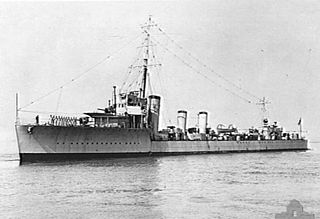
The Parker-class leaders or improved Marksman-class leaders were a class of six destroyer leaders built for the Royal Navy during 1916–17 for World War I service. They were named after famed historical naval leaders, except for Anzac, which was named to honour the Australian and New Zealand Army Corps, and was later transferred to the Royal Australian Navy. They were the last major Royal Navy warships to be ordered with three propeller shafts, a design that was never widely adopted in British warships.
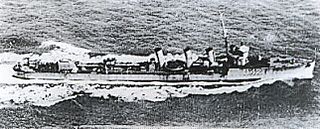
HMS Pasley was an Admiralty M-class destroyer built on the Tyne by Swan Hunter & Wigham Richardson for the Royal Navy and launched on 15 April 1916. She saw service during the First World War.
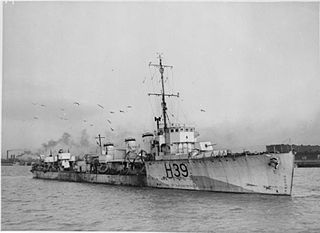
HMS Tarpon was a Royal Navy R-class destroyer constructed and operational in the First World War. She is named after the large fish Tarpon; one species of which is native to the Atlantic, and the other to the Indo-Pacific Oceans. Tarpon was built by the shipbuilders John Brown & Company at their Clydebank shipyard and was launched in March 1917 and entered service in April that year.

HMS Tornado was a Royal Navy R-class destroyer constructed and then operational in the First World War. She was sunk, with most of her crew in 1917. On 23 December 1917 HMS Surprise, HMS Torrent, and HMS Tornado sank after entering an Imperial German minefield.
HMS Negro was an Admiralty M-class destroyer of the Royal Navy. She was built by Palmers at Jarrow, Tyneside and launched 8 March 1916, but was sunk after colliding with HMS Hoste in the North Sea on 21 December 1916; depth charges from Hoste exploded and blew out Negro's hull plating. The ship was the second Royal Navy warship to bear the name Negro with the first being the 1813 Negro, ex-Niger.
HMS Medusa was a Medea-class destroyer of the British Royal Navy. She was one of four destroyers, of similar design to the British M-class ordered by Greece in June 1914, which the British purchased during construction owing to the outbreak of the First World War.
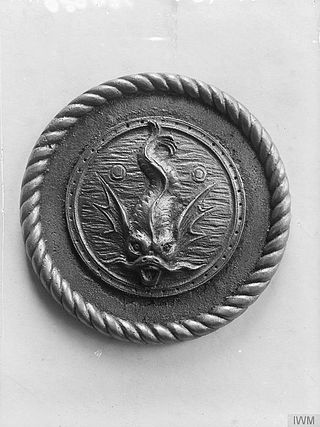
HMS Telemachus was a R-class destroyer of the British Royal Navy that took part in the First World War. She was built in 1916–1917 by the Scottish shipbuilder John Brown at their Clydebank shipyard. Telemachus was modified to serve as a minelayer, laying minefields in the German Bight and English Channel to restrict the operation of German submarines. The ship survived the war and was sold for scrap in 1927.

HMS Tirade was a Modified Admiralty R-class destroyer which served with the Royal Navy during World War I. The Modified R class added attributes of the Yarrow Later M class to improve the capability of the ships to operate in bad weather. Launched in April 1917 by Scotts Shipbuilding and Engineering Company, the vessel served with the Grand Fleet. The vessel was involved in escorting convoys in the Irish Sea and North Sea. During one of these duties, in September 1917, Tirade sank the minelaying submarine UC-55. During the following month, the destroyer accidentally struck and sank the M-class destroyer Marmion. After the war the destroyer was placed in reserve and then, in November 1921, was sold to be broken up.

HMS Marmion was a Admiralty M-class destroyer which served with the Royal Navy during World War I. The M class were an improvement on the previous L class, capable of higher speed. Launched in May 1915, the ship served as part of the Grand Fleet on exercises and escort duty. For much of the war, it was commanded by William Leveson-Gower, the future uncle to Elizabeth II. While involved in convoy escort duty off the Shetland Islands on 21 October 1917, the vessel was accidentally struck by Tirade in bad weather and sank. There were no survivors.
HMS Grenville was a Parker-class flotilla leader of the British Royal Navy. She was built by Cammell Laird during the First World War, being launched on 17 June 1916 and completing on 11 October that year. Grenville served with the Grand Fleet for the rest of the war, which she survived. The ship took part in operations in the Baltic during the Russian Civil War in the winter of 1919–1920, before entering a long period of reserve. She was sold for scrap in December 1931.
HMS Parker was a Parker-class flotilla leader of the British Royal Navy, and the lead ship of her class. She was built by Cammell Laird during the First World War, being launched on 16 August 1916 and completing on 13 December that year. Parker served with the Grand Fleet for the rest of the war, which she survived. The ship was sold for scrap in November 1921.
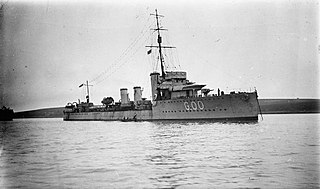
HMS Seymour was a Parker-class flotilla leader of the British Royal Navy. She was built by Cammell Laird during the First World War, being launched on 31 August 1916 and completing on 30 November that year. Seymour served with the Grand Fleet for the rest of the war, which she survived. The ship was sold for scrap in January 1931.
HMS Saumarez was a Parker-class flotilla leader of the British Royal Navy. She was built by Cammell Laird during the First World War, being launched on 14 October 1916 and completing on 21 December that year. Saumarez served with the Grand Fleet for the rest of the war, which she survived. The ship was sold for scrap in January 1931.
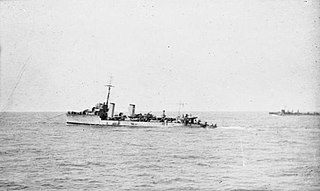
HMS Shakespeare was a Thornycroft type flotilla leader of the British Royal Navy. She was built by J I Thornycroft from 1916 to 1917 as the lead ship of her class, launching in July 1917 and completing in October 1917.
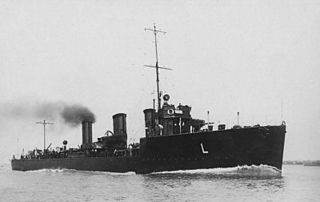
HMS Lochinvar was a repeat Laforey-class destroyer which served with the Royal Navy during the First World War. Named after the character in the poem Marmion, the ship was originally to be called HMS Malice but was renamed prior to being launched on 9 October 1915. The destroyer joined the Harwich Force and took part in anti-submarine patrols, as well as escorting the monitors Erebus and Terror for their attacks on the canal gates at Zeebrugge and the port of Ostend in 1917. After the Armistice, the vessel was placed in reserve and sold to be broken up on 25 November 1921.

HMS Marvel was a Admiralty M-class destroyer which served with the Royal Navy during the First World War. The M class were an improvement on the previous L class, capable of higher speed. The vessel, launched in October 1915, joined the Twelfth Destroyer Flotilla under the flotilla leader Faulknor. The ship saw action during the Battle of Jutland in May and June 1916, being hit by a 12 in (300 mm) shell that did not explode and jointly sinking the German torpedo boat SMS V48. Six months later, the vessel successfully rescued all but four of the crew of the sinking flotilla leader Hoste, despite sustaining substantial damage in the process. In June 1917, the vessel was involved in the sinking of the German merchant ship SS Gamma in Norwegian waters, which led to a diplomatic protest from the Norwegian government. At the end of the war, the vessel was placed in reserve until being sold to be broken up in May 1921.

HMS Marne was an Admiralty M-class destroyer which served with the Royal Navy during the First World War. The M class was an improvement on the preceding L class, capable of higher speed. The ship, the first Royal Navy vessel to be named after the River Marne, was launched in 1915. For much of the war, the destroyer escorted merchant ships in convoys and Royal Navy warships, but was also involved in the rescue of crew from the battleship HMS King Edward VII in 1916. The destroyer also took part in the Battle of Jutland as part of the shield for the British battleships and engaged with the German light cruiser force with torpedoes, although all missed. In 1918, the destroyer, along with sister ships Milbrook and Pigeon, sank the German submarine UB-124. After the armistice, Marne was placed in reserve before being decommissioned and, in 1921, sold to be broken up.

HMS Napier was a Repeat Admiralty M-class destroyer which served in the Royal Navy during the First World War. The M class were an improvement on the previous L-class destroyer, capable of higher speed. The vessel was launched on 27 November 1915 and joined the Grand Fleet. Napier had a varied war career, acting as part of the destroyer screen for the First Battle Squadron during the Second Battle of Heligoland Bight and searching for the survivors of losses like the armoured cruiser HMS Hampshire. The vessel was usually based at Scapa Flow but spent a brief time seconded to the Harwich Force in 1917. After the Armistice that marked the end of the First World War, Napier was placed in reserve before being decommissioned and sold to be broken up on 8 November 1921.

HMS Mindful was a Admiralty M-class destroyer which served with the Royal Navy during the First World War. The M class destroyers were an improvement on the previous L-class, capable of higher speed. The vessel, launched in 1915, joined the Twelfth Destroyer Flotilla under the flotilla leader Faulknor. The ship saw action during the Battle of Jutland in May 1916 and helped sink the German torpedo boat SMS V48. In March 1917, the destroyer was involved in a friendly fire incident, nearly sinking the British submarine G12. In June that year, the vessel was involved in the sinking of the German merchant ship SS Gamma in Norwegian waters, which led to a diplomatic protest from the Norwegian government. At the end of the war, Mindful was withdrawn from service and, in 1921, sold to be broken up.











